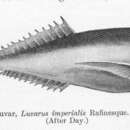en
names in breadcrumbs


The louvar or luvar (Luvarus imperialis) is a species of perciform fish, the only extant species in the genus Luvarus and family Luvaridae. It is closely related to the surgeonfish. The juvenile form has a pair of spines near the base of the tail, like the surgeonfish, though they are lost in the adult.
It is a large, ellipsoidal fish, growing to 200 cm (79 in) long, though most do not exceed 152 cm (60 in). The greatest weight recorded for this species is 150 kg (330 lb).[3] It is pink in color and possesses a characteristic bulging forehead.
It is found in surface waters of temperate and tropical oceans throughout the world where it can be found at depths of from near the surface to 200 m (660 ft). It feeds on jellyfish, ctenophores, and other soft-bodied planktonic animals. It is hardly ever found in fish markets in the United States, only as bycatch, but is prized as an eating fish.[4]
One extinct species in the genus Luvaris and two extinct genera are only known from fossils dating back to the Paleogene, three extinct genera if one includes Kushlukia of the monotypic Kushlukiidae:
The louvar or luvar (Luvarus imperialis) is a species of perciform fish, the only extant species in the genus Luvarus and family Luvaridae. It is closely related to the surgeonfish. The juvenile form has a pair of spines near the base of the tail, like the surgeonfish, though they are lost in the adult.
It is a large, ellipsoidal fish, growing to 200 cm (79 in) long, though most do not exceed 152 cm (60 in). The greatest weight recorded for this species is 150 kg (330 lb). It is pink in color and possesses a characteristic bulging forehead.
It is found in surface waters of temperate and tropical oceans throughout the world where it can be found at depths of from near the surface to 200 m (660 ft). It feeds on jellyfish, ctenophores, and other soft-bodied planktonic animals. It is hardly ever found in fish markets in the United States, only as bycatch, but is prized as an eating fish.